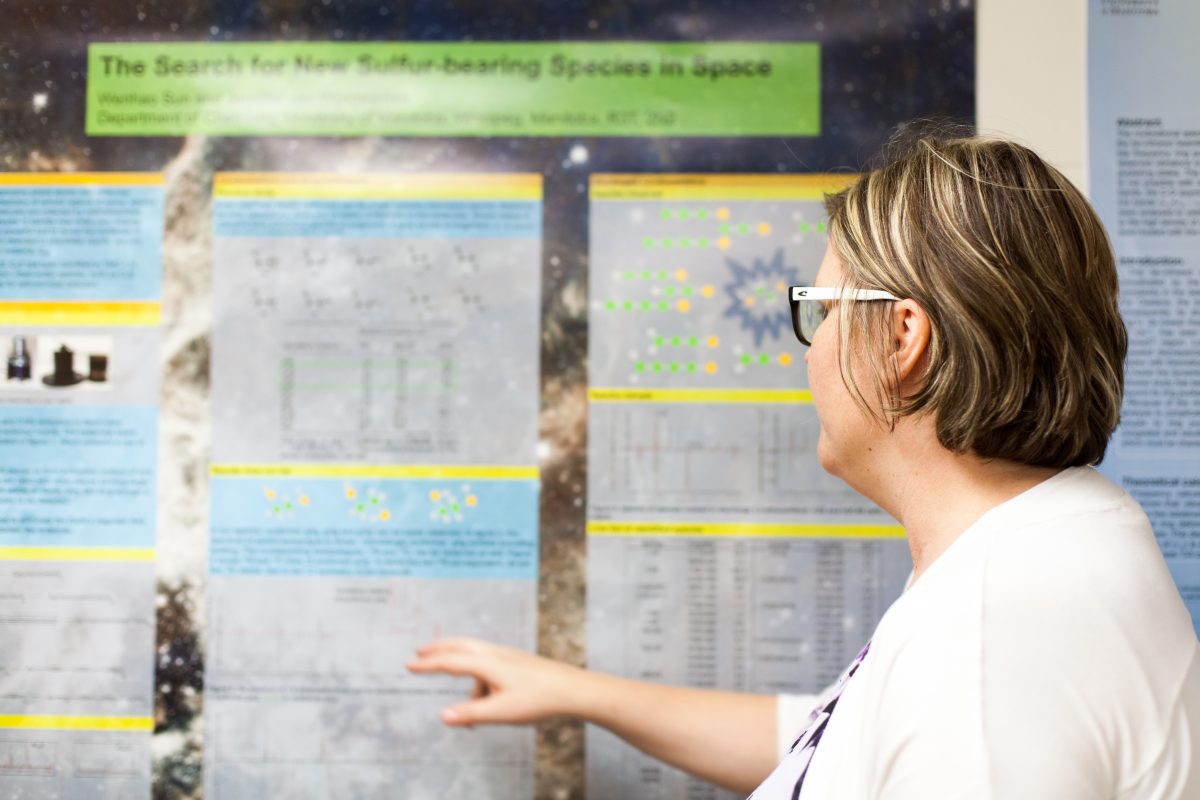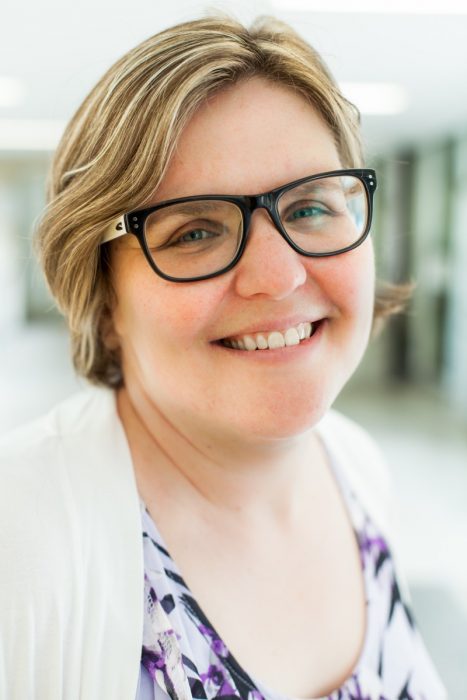
Photo credit: Kira Koop.
Puzzling it out: solving the mysteries of molecules, one spectrum at a time
Asked what it is about her specialty (microwave and infrared spectroscopy) that she finds so appealing, UofM Chemistry Professor Jennifer van Wijngaarden thinks for a moment before answering:
“I like that it’s essentially a puzzle, and you’re finding the best solution. There’s never a perfect one. You’re just constantly trying to find the best way to do something. The stuff that I’m drawn to is the theoretical aspect, trying to understand what a spectrum is telling us about a molecule. Sometimes we’re just developing something from scratch to derive what the model should be to explain what we’ve observed.”
For the uninitiated, microwave and infrared spectroscopy is the study of the movement of molecules on a microscopic level. Van Wijngaarden and her team research the properties of these structures, including the way they interact with one another. Crucial to our very existence, molecules make up everything in our world, including us.

Photo credit: Kira Koop.
van Wijngaarden wasn’t always interested in studying these tiny bits of matter. It took until her last year as an undergrad and a course on Advanced Quantum Mechanics taught by Dr. Rob Lipson (currently Dean of Science at the University of Victoria) to change her focus. Lipson’s enthusiasm for his subject was so infectious that van Wijngaarden ended up entering a related field in grad school.
“Before [Professor Lipson’s class] I had been thinking about doing graduate school, but in a much more applied engineering field. That class really pointed me much more to spectroscopy, the fundamental properties of molecules and more pure science than where I was originally headed.”
Where van Wijngaarden was originally headed was medicine. Growing up in a small Ontario town, she didn’t have a clear idea of the variety and scope of professions that were potentially available to her.
“It’s silly now to say, but at the time I didn’t really know what one could do. If you had good grades and you were smart, then you wanted to go to medical school. I didn’t know any PhD level scientists when I was growing up. That’s something now when I’m teaching students, I sort of see the same thing. A lot come in thinking about professional schools because these are jobs that they know or have encountered and [they don’t] understand what other things are possible.”
Van Wijngaarden feels like she’s paid her dues when it comes to starting up her own lab, which she inherited in less-than-ideal condition. Forgoing the purchase of ready-made instruments, van Wijngaarden and her students instead custom-made them for their requirements. She has come a long way from her early days, building instruments and doing more safe projects for publication.
“[N]ow we’re doing the more interesting chemistry that I wanted to do from the start, which is coming up with ways to generate species that aren’t stable under normal atmospheric conditions. These are the types of molecules you find around stars and far-out planets and moons that drive the evolution of the Universe.”
Starting around 2010, van Wijngaarden and her students started to become very good at re-creating work previously done by other researchers. It was a long time before the team started seeing new molecules. Van Wijngaarden went through three post-docs to improve the technical aspects of the instruments with no new molecular discoveries. It’s only been in the last year and a half that she and PhD student Wenhao Sun have seen four or five brand-new, never-reported species. It’s been very exciting, and van Wijngaarden is confident that the resultant scientific papers will be published to much fanfare.
Currently, Van Wijngaarden is better known for her work with the synchrotron at the University of Saskatchewan’s Canadian Light Source. The synchrotron is a brilliant source of light produced by using radio frequency waves and powerful electro-magnets to accelerate electrons to nearly the speed of light. Different wavelengths of light are directed down beamlines, which researchers then use to gather information about the structural and chemical properties of materials at the molecular level.
Coinciding with the beginning of her employment with the UofM in 2006, the beamline at CLS started accepting proposals. Despite not knowing anything about the synchrotron, van Wijngaarden jumped in with both feet. She simultaneously built up her own lab and spent a great deal of time in the early stages of CLS, earning a reputation as an expert in the field. In fact, van Wijngaarden has become so well-known in the synchrotron community over the past decade that she was recently asked to join the CLS Board of Directors, a rare honour for someone at this stage of her career.
“The challenge is that I only get a few weeks of beam time a year. So you have to go out there and work like crazy for four or five days and hope for the best, and if it doesn’t work, you don’t get another shot for four or five months. So it’s a difficult project to put students on. I’m wishing I had a synchrotron in my backyard, then we could move that along faster,” van Wijngaarden says with a laugh.
Not that van Wijngaarden is the type to let a challenge get her down. She continues to take on new projects which often starts with recruiting students with an interest in both experiment and theory. Spectroscopy is still her passion, as is the process of teaching and mentoring her students.
“What I like the best about students [is that] it’s a really fun relationship to have when they get to the stage where they have more time to really think and invest in their project. They’re learning things and telling me about them after the fact, which is the ultimate goal.”
Research at the University of Manitoba is partially supported by funding from the Government of Canada Research Support Fund.






